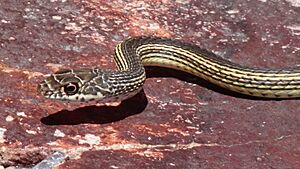Striped whipsnake facts for kids
Quick facts for kids Striped whipsnake |
|
|---|---|
 |
|
| Desert striped whipsnake, Masticophis taeniatus taeniatus | |
| Conservation status | |
| Scientific classification | |
| Genus: |
Masticophis
|
| Species: |
taeniatus
|
| Subspecies | |
|
Two, see text. |
|
| Synonyms | |
|
|
The striped whipsnake (Masticophis taeniatus) is a type of non-venomous snake. This means it is not harmful to people. It belongs to the Colubridae family, which is a large group of snakes. This snake is a close relative of the California whipsnake. You can find the striped whipsnake in the western United States and parts of northern Mexico.
Contents
What Does It Look Like?
The striped whipsnake can grow to be about 30 to 72 inches long. That's about 2.5 to 6 feet (76 to 183 cm), including its tail! Its back can be black, dark brown, or gray. Sometimes it has a hint of olive green or blue.
This snake has a dark stripe along the middle of its first four rows of scales. It also has a white or cream-colored stripe on its side. This side stripe often has a solid or broken black line running through it. The snake's belly is usually cream or yellowish near its head. It turns a coral pink color closer to its tail.
Where Does It Live?
The striped whipsnake lives across the western United States and northern Mexico. You can find it as far north as south-central Washington. Its home range then stretches south through the Great Basin. This area is between the Cascade-Sierran mountains and the continental divide.
The snake's range also goes southeast across the continental divide. It reaches into New Mexico and western and central Texas. The farthest south it lives is in Michoacán, Mexico. In the western U.S., it also lives outside the Great Basin. You can find it in the Rogue River Valley in southwestern Oregon and northern California. There is even a group of them in Bryce Canyon National Park in Utah.
Where Does It Like to Live?
Striped whipsnakes live in many different places. They are often found in shrublands and grasslands. They also like sagebrush flats, canyons, and woodlands with piñon and juniper trees. Sometimes they live in open pine-oak forests.
These snakes are often found near rocky streams, whether they flow all year or only part of the year. They live in both flat areas and mountains.
How Does It Behave?
The striped whipsnake is active during the day. This means it is a diurnal animal. It is very alert and moves quickly. When it needs to hide, it looks for shelter in rock cracks. It also uses burrows made by small mammals. Depending on where it lives, it might hide in trees and shrubs too.
This snake is not venomous, so it doesn't have harmful venom. However, it is a predator and eats many different animals. Its diet includes lizards, other snakes (even venomous rattlesnakes!), small mammals, young birds, frogs, and insects.
Reproduction
The striped whipsnake lays eggs. This is called being oviparous. Scientists don't know a lot about how these snakes reproduce. After mating, the female snake will lay a clutch of 3 to 12 eggs. She usually lays them between June and July. Often, she chooses an abandoned rodent burrow for her eggs. One study found that the eggs hatch naturally after 44 to 58 days.
Different Kinds of Striped Whipsnakes
There are two types, or subspecies, of the striped whipsnake that scientists recognize.
- Masticophis taeniatus girardi (Stejneger & Barbour, 1917)
- Masticophis taeniatus taeniatus (Hallowell, 1852)
If you see a name in parentheses after a subspecies, it means that subspecies was first described under a different genus name.
Where Did Its Name Come From?
The subspecific name, girardi, honors a French-American scientist named Charles Frédéric Girard. He studied reptiles and amphibians.


